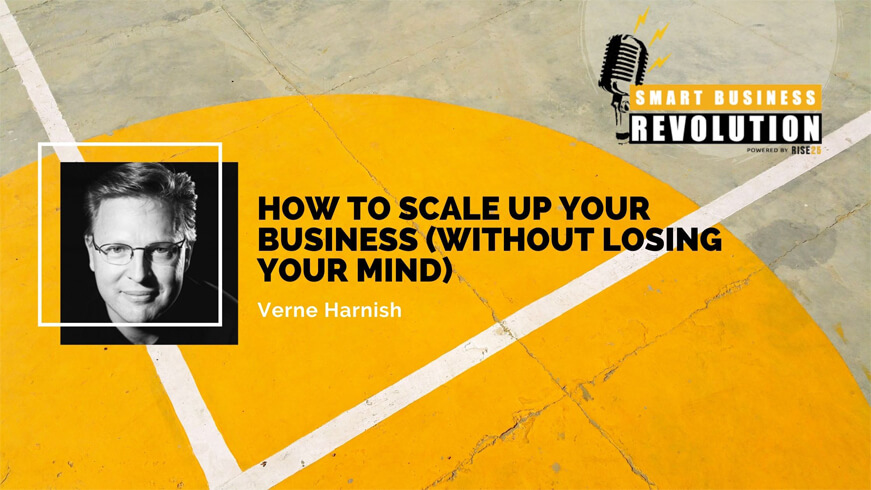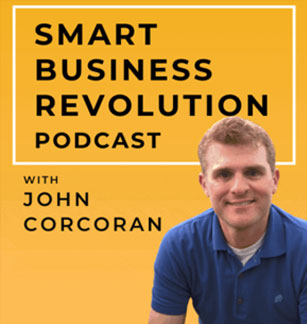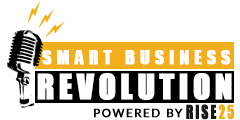

Verne Harnish is the Author of Scaling Up: How a Few Companies Make It…and Why the Rest Don’t (Rockefeller Habits 2.0) and the Founder of the world-renowned Entrepreneur’s Organization (EO), with over 13,000 members worldwide, and chaired for fifteen years EO’s premiere CEO program, the “Birthing of Giants”, a program in which he still teaches today.
Verne is also the Founder and CEO of Scaling Up, a global executive education and coaching company with over 200 coaching partners on six continents. Verne has spent the past three decades helping companies scale-up and this topic we’ll be focusing on today.
In this episode, we also talk about:
- Why Verne Decided, On Multiple Occasions, to Scale Back on Work and Focus on His Family
- How Verne Began Helping Other Businesses Scale Up
- The Origin of Verne’s Birthing of Giants Program at MIT
- How Verne’s Managed to Build Relationships with the Likes of INC., MIT, and More
- How Verne Got President Ronald Reagan, Steve Jobs, Mark Cuban, and Other Huge Names to Attend an Event for His Student Entrepreneurs Organization
- Why You Need a Bold Vision
- Why Verne Still Creates Influencer Lists for Outreach When Working on New Projects
- Who the Number One Influencer is on His List Currently and Why
- How Watching His Father Lose It All After Having a Successful Business Impacted Who Verne is Today
Sponsor: Rise25
This episode is sponsored today by Rise25, the training company founded by my business partner, Dr. Jeremy Weisz and myself with the mission of helping business owners from professional services get away from trading hours for dollars and shift from one to one client work to one to many programs and offers.
We are building a community of entrepreneurs who realize the world and economy is changing and who want to work smarter than trading time for money so they can scale up their business and spend time doing what they love.
Check out Rise25 to learn more about our retreats and training programs.
Right Click here to download the MP3
Click here to subscribe via iTunes
Advertise on the Smart Business Revolution Podcast
Episode Transcript
John Corcoran 0:39
Alright, welcome everyone. My guest is Vern harness He is the author of scaling up how few companies make it and why the rest don’t Rockefeller habits 2.0 but first before we dive into this interview, this podcast is brought to you by rise 25 rise 25 puts on curated events for high level entrepreneurs at conferences and seminars ladies and more conference ticket sales were exhibitor dollars, much higher satisfaction levels, if you have a community of business owners gathering for a conference or a seminar, and you’d like to increase attendance without spending money on a Raspberry Pi VIP day, maybe the perfect solution for you, you can learn more and find out if your community qualifies at rise 25 dot com now on our show, it’s my huge honor to welcome my guest Vern harder. She is the founder of the world renowned entrepreneurs organization, he Oh as it’s known over 12,000 members worldwide. He also chaired for 15 years he is premier CEO program, the birthing of giants program held at MIT, which I’m going to ask about. He’s also the founder and CEO of gazelles, which is a global executive education and coaching company with over 210 partners on six continents. He’s involved in so many different things that I could spend my whole time in, leading into the intro, but we’ll just jump straight into it. Now, I wanted to ask you about this verse, because I was reading about your background beforehand. And you had this story, when your son was six years old, you kind of took a step back from your business. And this actually happened, I read a couple of times, you also had a sister have some health issues. And so I just want to ask you about that. Because on the one hand, your book and your mission through gazelles is to help businesses to grow. On the other hand, you do say you need to prioritize the personal first, and you lead by example, in that situation. So when I asked you about is how do business owners reconcile those two? How do you draw the line? How do entrepreneurs who are listening to this make those sorts of tough decisions about when to prioritize the personal over the professional?
Verne Harnish 2:40
You know, john, first of all, it’s great to be on the show. And you know, I’m a big fan of influencers and all the importance of that it was actually Michael Gerber, he was speaking at our university in Chicago, and he was 70 at the time, and I’m sitting the audience, and my wife, Julia just had our fourth child Quinn, and I’m just man, I can do this, when I’m 70, I’ll probably have worked a total of 70 or 80 years in my lifetime, you know, why not take 10 years off and really focus on the family. So that was a personal decision of mine, I, I don’t think I can show it on anyone else relative to what it is that they want to decide. But for me, it was kind of a cost benefit analysis, which is what I think most entrepreneurs have to make. And we’ve done well enough financially at a point that I could step back, I didn’t retire. But I scaled back my time. And here’s the irony. In the time that I’ve spent outside the country, the business actually scaled, even though I was gone. And I think part of it was because I did step out, and it forced some decisions to be made relative to other leaders in the organization, leading components of our business, other people stepping up, and me really getting out of the way, you know, we actually teach that you should be able to run the company a day a week, I did a Huffington Post piece by one of our clients who runs five companies on Thursday. Well, that’s part of what we want to do with our tools is help people get back the freedom that they always wanted when they launched and grew a company but seem to have lost as this company begins to kind of close down around them. So it all fits within our mission.
John Corcoran 4:22
Now, you’ve been coaching businesses on scaling up for about 30 years or so. And what struck me is that’s not really like an entry level type of roles. You know, I mean, usually businesses have a lot of experience are usually entrepreneurs or consultants have a lot of experience before you get into that type of work. So how did you originally get into this particular area of helping businesses with scaling up,
Verne Harnish 4:47
my dad had a very successful company I was growing up, my grandparents had companies that I grew up around. And then my dad and I launched a little company when I was 15. And so I felt like I we’d scaled it up. And then I was involved in scaling a company while I was in college to about 12 million. So I felt like I’d had many years of experience when I had this opportunity approached by a wealthy individual of Kansas, who was building the Center for Entrepreneurship there that come in and as an option,
John Corcoran 5:17
help him build this organization that was going to help young people start companies. And it was out of that, that I launched then as the then ultimately Why do which is now yo what what I’m doing today. Tell me about the birthing of giants program at MIT. It’s kind of a little bit legendary, particularly within the eo community. And by the way, I don’t think I mentioned in the introduction, but I belong to eo accelerator, which is a great program within the eo organization. It’s It’s how I got to know, but previously had read your book, but how I got involved in the content that you teach. So tell me a little bit about that, the origins of it, and how that plays into all the different companies that you’re involved in now.
Verne Harnish 5:59
But when we launched white Yo, it was clear that we wanted it to really mere IPO and IPO for years and had a program and executives still does has a partnership with Harvard, and their executive program. So I went across the street, Harvard, said, Hey, we’d like to do some similar. They’re like, no way. I want to cross the street, then to MIT, and had some great relationships that I had nurtured earlier, some real influencers there within Inked magazine, and MIT. And so it was really amazing. They embraced this young organization, we had about 156 members at the time, and trusted me to tap their brand, the MIT brand and the ink magazine brand to our fledgling organization. And those two so most really helped us 10 X the organization through that executive program that I designed and launched in 91. With some great, you know, first members in that class, Brad Feld, Brad’s got on obviously to be a very successful VC and co founder of TechStars, and all the things that he’s done and Allen traveler who got the multi billion dollar peg his systems, Ted Leonsis is in that first class you know, Ted up Steve Case, scale AOL and and finally won his Stanley Cup. You know, his his Washington Capitals finally did it. Two months ago, Karen Banki, who’s coming on, built multiple companies, including our lateness with Gwyneth Paltrow, to beauty on and on and on, it was a spectacular first class that I think really set the stage for us to attract the right entrepreneurs that wanted to scale into that program. We’re still running it today. It’s called EMP, they still let the old man come back and teach in it in the opening session once a year. So it’s been great to stay attached to that program.
John Corcoran 7:46
And it’s a couple of weeks in the summertime, is that how it works? Is it not as
Verne Harnish 7:49
I see the program, but Harvard’s like three weeks, and we figured entrepreneurs can do it in three days. So it’s a Wednesday evening through Sunday, once again, for three years,
John Corcoran 8:01
once a year, for three days. For three years, you got an interesting, interesting structure are the people that belong to this or they also belong to you?
Verne Harnish 8:10
Yeah. And initially, it was actually a really great recruiting tool. I know that first class ink magazine, Bernie Goldberg, she became a great friend of mine, the owner rest his soul of ink magazine, he gave us full page ads, and those ads would draw, you know, seven or 800 applicants out of which we choose 60. For the program, now that he has now almost 13,000 members, it’s exclusively just for eo members today.
John Corcoran 8:36
Hmm. Now, you’ve mentioned a couple of major organizations, Inc, MIT, these are old institutions been around for a long time. And yet, you must have some means of penetrating them reaching out. This is like one of the biggest challenges I think business owners face, which is how do you connect? How do you build relationships within whether it’s a prospective client referral partner perspective business partner, especially with larger organizations that have clout that have standing in the marketplace? So can you give us some insight into between Inc, MIT, these different types of organizations that you’ve managed to partner and collaborate with over the years?
Verne Harnish 9:17
Well, you know, I think it’s two things. I think it’s just being bold and having a bold mission. So my dad has successful company, but then he lost it all. And we were quite not well off when I was heading to college. And I’d read how Andrew Carnegie said it was critical that you live in the right neighborhood. So I managed to finagle a job with a company called spirit Supply Company, which Tom and like almost on the first day of the job, I had heard that the President was a white CEO, or the owner was well off and knew everybody in town and lives in a beautiful place. And I just walked up to Don Simpson and said, Hey, Don, I’m one of your new engineers, freshman here, Wichita State University. And I’m wondering if I could live with you and your wife at the let’s step back, like, all right, I told him Andrew Carnegie story. And he said, Well, let me check with my wife. And lo and behold, they would leave every winter for Florida. And they thought it was a good idea that maybe somebody would be there in their home over the school year. So here, I ended up having this beautiful place. You know, I think they charged me $50 a month in this beautiful neighborhood. And it really allowed me to build a very close relationship with God, chairman of the company, who then introduced me to this Dr. Fran to bear that got me in the whole entrepreneurship world. He introduced me to the who’s who within Wichita I met the Carney brothers who founded pizza hot and Tom who did run a center and Charles Koch, you know, Koch Industries I Treasury then of one of his organizations will a Garvey, the Garvey family, one of the Forbes 400 on and jack, the board went on to do Residence Inn and all of that, and many of them became later supporters of other activities I was involved in, but the guy that really changed my life, when I went to launch, first a association of collegiate entrepreneurs. I had been reading about Regis McKenna, this great marketing guru and Silicon Valley, who was advising Steve Jobs, no help Steve scale to a billion and intelligent ed tech and almost everybody else in Silicon Valley. And I’m like the student Wichita State. And I said, Look at these good enough for Steve. He’s good enough for me. So I just cold call his organization. And I can you I think you’ve got to have an outstanding elevator pitch. And mine was, hey, I want to build the world’s largest entrepreneurship organization. For people like Steve Jobs. It’s a long story short, but Regis still kids me today. They took your call, you took my call, and I was only free client he ever had the history of the firm. And he said, All right, I’m going to sign a young guy, rich Moran to you. And we’re going to, you know, get you on a phone call one hour a week, sent me out the booklet, the manual that he had said to Steve Jobs and everyone else, and they started taking me through it. The key question, he wrote this book called relationship marketing, the key question that Bill Gates considered the best question he’d ever been asked. And the question was, what are the top 25 influencers? Top 25 relationships, you need to bolt on to this student organization if you want to scale it quickly. And I remember, john taken out a yellow Notepad, and rich Moran, who still I’m very close with today, said all right, the bigger the names, the faster you’ll scale, just be bold. And so I wrote down, it’s 1983. President Ronald Reagan, I said, Look, if I can get the president to get behind my student entrepreneurship organization and be the first president, ever, under the word entrepreneur, that’ll be significant. And I wrote down Steve Jobs, Michael Dell, Michael was just coming on the scene. Ink magazine. I didn’t know who owned it, but I knew I needed them behind us adventure magazine, I remember, those are the top five names on my list of 20 five, and then we can get into the details of how I got to them and how I convinced them and all of that, but 36 months later, we were global. And it’s 1986. I’ve now hosting the first public speech of Steve Jobs. Since you’ve been fired from Apple. I’ve got President Ronald Reagan agreeing to fly in to do the opening. I’ve gotten Adele sitting there at the head table with Steve Jobs along with Mark Cuban and Kevin Harrington and Neil balter, many Jimmy Collado, and many of the very successful young entrepreneurs in their 20s. And I’ve got ink magazine, they’re covering it. We ultimately got a six page story. And I’ve got Arthur Lipper with venture magazine who still is a dear friend of mine today, who ended up giving us massive coverage for our ace 100 throughout that entire growth period. So those first five on the list that I ultimately got invited to the White House, as Reagan then transitioned into Bush to come in and kind of advise them on their own Aereo policy moving for it all happened in 36 months job.








